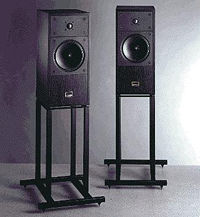Fascinating. This little box defies all the norms of loudspeaker cabinet design, including the notion that boxes should be seen rather than heard. If you put 10 speaker designers in a room, they’ll argue over everything from the advantages of infinite baffles and ribbon tweeters to electrostatic panels and cone materials, but none of them will suggest that cabinets should be intentionally resonant. Instead, they all start from the opposite direction: they know cabinets desire to resonate, but they do everything they can to prevent it.
The Onkyo D-TK10 isn’t one of them. It doesn’t have a highly braced cabinet that tries to be as acoustically inert as a concrete block – despite the fact that it does store energy like one. Rather, the cab is designed to reverberate like an acoustic guitar (albeit in a highly controlled manner). It’s no wonder, then, that it was developed in collaboration with Takamine, a Japanese guitar manufacturer that knows a thing or two about generating lovely tones out of shaky bits of wood.
The D-TK10 is a two-way bass reflex design that is compact (133x276x220mm) and light (2.9kg), and is finished in exquisite rosewood that, according to all hi-fi loudspeaker design guidelines, does not generate a dull thud when ‘rapped’ with your knuckles. The woodwork is lovely, bent like a guitar, with a small cant back from bottom to top on the front baffle. The ‘Takamine Acoustic Voicing Technology’ produces very thin sidewalls that are adequately supported in crucial locations. Curvatures in the wood were employed to provide strength instead of using thicker materials such as MDF.
Takamine is a well-known Japanese guitar maker with a nearly fifty-year history. Onkyo approached the company ten years ago for advice on how to put their idea of making a speaker enclosure out of the body of an instrument into practice, and the result was a collaboration that finally hit Japanese stores in December 2005, though the D-TK10 took a year or two to reach the UK market.
It has a 100mm ‘Onkyo Micro Fiber’ bass unit, which is made up of an exterior polyethylene naphthalate (PEN) layer, an inner Aramid layer, and a flexible cotton weave layer sandwiched between them. At 3.5kHz, the speaker switches to a 25mm metal ‘Ring Drive’ tweeter. A single front slotted bass port made of rosewood is a long thin duct that Onkyo refers to as a ‘Aero Acoustic Drive’ to emphasize how different it is from a traditional circular port. It’s a gorgeous item to look at and feels very exotic, despite the fact that it’s only the size of a matchbox.
It also sounds like it. It is, without a doubt, one of the most distinctive loudspeakers I have ever examined. It is not particularly accomplished in certain areas, yet it possesses exceptional abilities in others, allowing it to stand out from the crowd. First and primarily, the D-TK10 performs TARDIS-like spatial and scale manipulations. I’ve never heard a small (nearly minuscule) loudspeaker so effortlessly drive my large listening space. A pair of the small Onkyos, standing over a meter tall, sung like a bird and sounded as free as one…
The tonality, which is rich and mellow, is the next thing that strikes you, and it doesn’t come from simply increasing the bass port’s contribution to the proceedings. The D-TK10 is, in fact, the first ‘fruity’ loudspeaker I’ve heard in a long time. But this coloration is unlike any other I’ve seen, because it comes from the guitar-like sidewalls that are quietly and benignly thrumming in the background. If you’re not sure what those cabs do, pick up an acoustic guitar, pull the bottom strings hard, and listen – then insert a T-shirt into the guitar’s aperture (to dampen the body) and do the same thing. This clearly demonstrates how resonance, when done right, can be beneficial!
The D-timing TK10’s is the next most impressive feature; few loudspeakers at any budget can match it. For me, this is a critical aspect of any speaker’s performance. The small Onkyo, however, does not sound like your typical well-timed speakers. When you combine such magical expanse with the great tone and impeccable timing, you have an extremely engaging loudspeaker. It is, without a doubt, one of the most energetic and joyful-sounding instruments I have ever heard. It’s the ideal party speaker, not because it produces a loud, booming sound, but because it instils power, passion, and joy in everything it touches.
Using traditional standards, evaluating Onkyo’s D-TK10 is quite difficult. Because it is colored, it is not suitable for classical music fans looking for a translucent acoustic lens. The modest rose hue, on the other hand, worked perfectly with every other form of program content. Then there’s the frequency range; speakers this small don’t have a lot of low bass, and the treble was less crisp and atmospheric than some similarly priced competitors. It isn’t perfect, but after living with a couple for a month, I found myself tolerating their flaws. That’s because it’s highly musical and timed well by any standard; switching to a ‘regular’ speaker causes the music to slow down and falter.
This incredible speaker has become somewhat of a cult favorite. Despite the fact that there are a lot of them on the secondhand market, you have to pay for the privilege of owning a pair. “A future classic in the making, and an instant cult loudspeaker,” I said nearly a decade ago, and I was correct!







